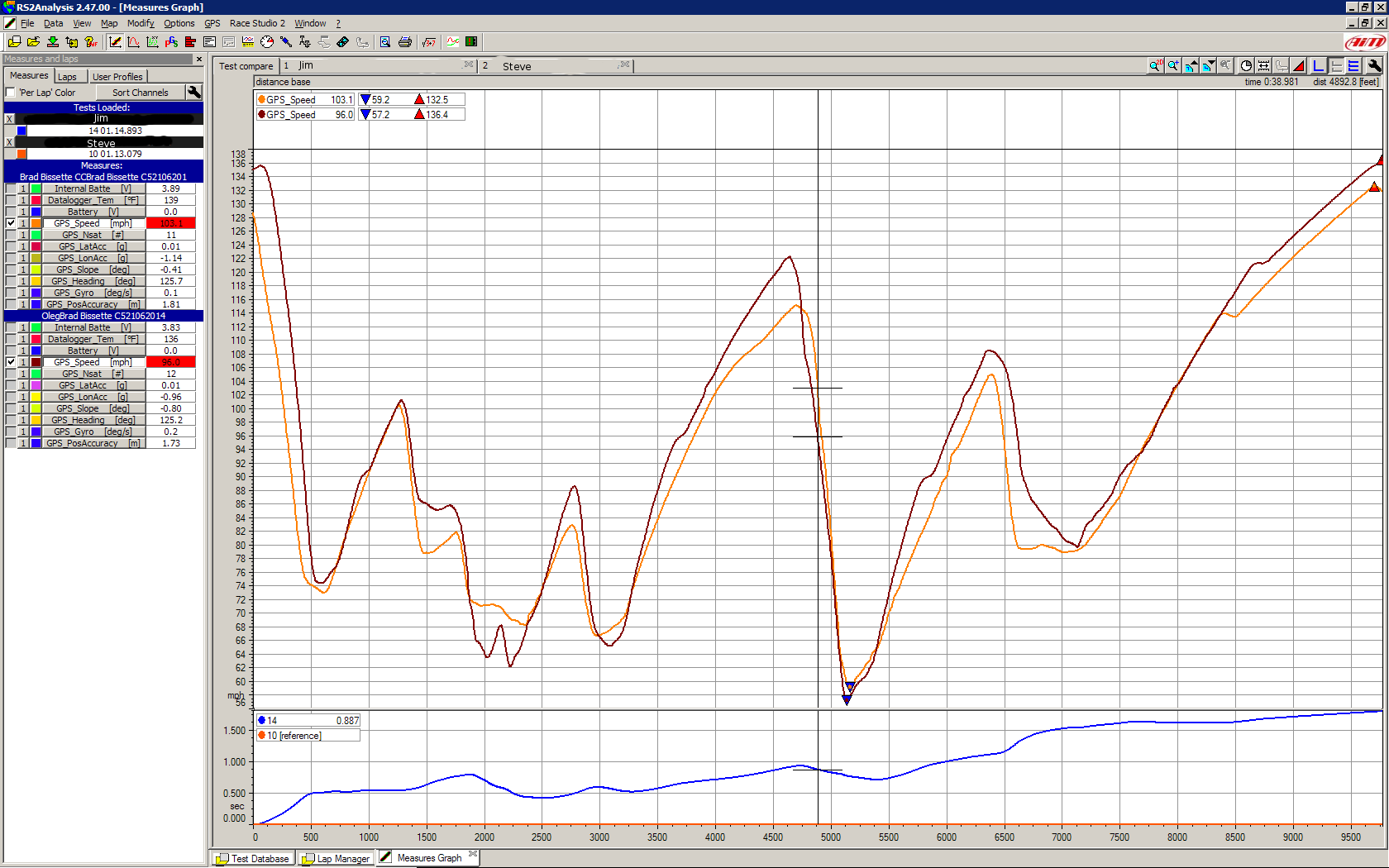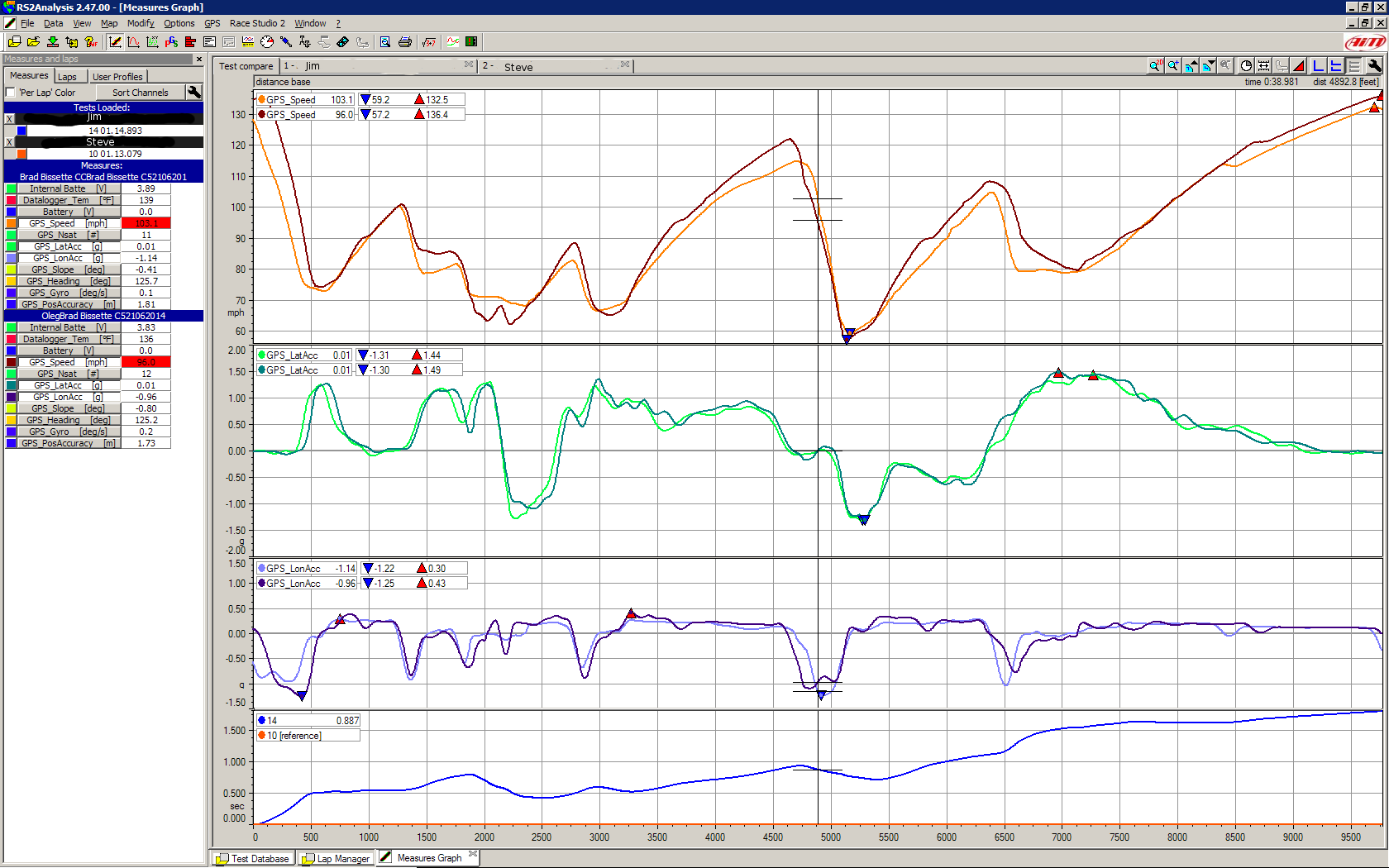NJMP Lightning Corvette Data Analysis
Published: July 10, 2014
This is an analysis of the best laps of two drivers on NJMP Lightning. Both drivers used the same car and ran on the same day, making this a back to back test. The car is a C5 Z06 Corvette on Hankook R compound tires.
Jim ran first and posted the benchmark time of 1:14.98. Steve ran second and had as his goal to beat Jim's time without overdriving the car. Steve expected the gains to come primarily from later apexes and higher mid-corner speed:
- Many drivers of high power cars do not apex sufficiently late, which delays their power application on corner exit. Steve's goal was to get on throttle as early as possible. The next goal was committing to full throttle as soon as possible.
- Steve suspected he might have had more aggression than Jim, and as such would have be able to maintain a higher speed through the turns. However, given the constraint of not overdriving the car, Steve relied on traction sensing to stay under the grip limit of the tires at all times.
- As the car had anti-lock brakes, Steve did not expect to gain any time in the braking zones, thus his goal was to apply maximum braking in all braking zones to match Jim's braking and be consistent with his braking points.
In his session, Steve posted a best lap time of 1:03.79. Data traces for the two drivers is below:
Turn 1
Steve starts braking much later and is harder on the brakes. Steve gains 0.5 seconds on Steve in the braking zone for turn 1.
Braking later makes sense. Turn 1 is an uphill turn and as such requires less braking than a flat turn with the same curvature would. Less aggressive drivers often do not use the elevation change and take the turn as if it was flat.
Braking harder is surprising, given that both drivers should have been close to ABS engagement. It is possible that Jim was applying partial brake input without realizing this.
Looking at the G plots, Steve has a little more overlap between braking and turning. It also looks like Steve might be running a later apex than Jim. The later apex is most suggested by the steeper drop in lateral Gs toward the end of the turn where the two traces meet - both drivers finish the turn at the same point on the track but Steve starts the turn later and unwinds steering quicker once rotation is performed.
Turn 2
Steve stays on full throttle a fraction of a second longer and carries more speed into turn 2. This cut about 0.25 seconds in turn 2.
Turn 3
Turn 3 is not distinct on data traces, but it looks like both drivers take it roughly the same way - off power and on brakes.
Turn 4
This is where Jim trounces Steve. Steve was braking into turn 4 and accelerating between turns 4 and 5. Jim preserved speed into turn 4 and came out 0.6 seconds ahead. The exit speed is the same for both drivers, but Jim maintained a higher speed through the turn. The straight between turns 4 and 5 is not long enough for Steve to recover from the loss of time due to braking into turn 4.
Turn 5
Steve stays on throttle longer and brakes harder. Steve also appears to be in a lower gear coming out of turn 5.
An important aspect of turn 5 entry is to have a solid braking reference point. Good candidates are center line of the track, 1/8 toward the left or feet of tape or old boxes.
Turn 5 entry moves Steve about 0.2 seconds ahead.
Shortly afterward though Steve brakes more than Jim and is slower at the apex, losing 0.1 seconds. This may be a confidence issue as Jim has much more time in the car than Steve does.
Looking at corner exit, Steve is in a lower gear and despite being slower at the apex, Steve makes up all of the lost speed and then some. It is interesting that even with a shift, Steve is faster than Jim everywhere on the 5-7 straight. Another interesting observation is that exit speed trumps minimum corner speed - Steve gains more time on the 5-7 straight due to better exit out of 5 than he loses in turn 5.
Turn 6
The track map shows a turn 6 between turns 5 and 7. Realistically this turn should be taken flat out in every car, and thus it can be considered a straight.
Many people lift on the 5-7 straight, some in around the apex of turn 6 (the car tends to be mid track at that point though, not at the apex), and some toward the braking zone for turn 7. It looks like Jim is easing off the gas as he approaches turn 7, whereas Steve continues to accelerate until his braking point. By staying on the throttle Steve gains another 0.7 seconds by the braking zone for turn 7.
Turn 7
Steve starts braking earlier than Jim. By the time Steve set his best time, the tires started to overheat and go away, and this necessitated braking earlier. Even so, Steve and Jim have identical speeds through the braking zone. Both drivers should be able to brake harder - and therefore later - on cooler tires.
As with turn 5, Steve exits turn 7 in a lower gear and even though Steve is later on the throttle he comes out 0.2 seconds ahead by the time he shifts into 4th gear. My guess is Steve ran a later apex in 7 than Jim. Exit speed - in this case, having the car straight enough to put all available power down - again trumps taking the turn faster.
As with 5-7 straight, it is beneficial to use a lower gear and shift in the middle compared to staying in the higher gear the entire time.
Turn 9
Steve is on the throttle later and brakes gentler, carrying speed from the straight between turns 7 and 9 much deeper into turn 9. This is worth approximately 0.5 seconds. Steve was largely driving turn 9 entry by feel rather than reference points; if he had reference points, he would have been able to brake deeper still.
A notable difference in turn 9 is Steve never hold a constant speed - he is decelerating until the turn in point and accelerating afterward. Contrast this with Jim who applies maintenance throttle for a significant portion of corner entry.
Conclusion
Going faster in a high power car is a function of:
- Running late enough apexes, to be able to put available power to the pavement.
- Concentrating on corner exits rather than being fast in the corners.
- Having reference points for braking.
- Traction sensing in the turns themselves.
Tagged: data analysis


 Visit our
Visit our